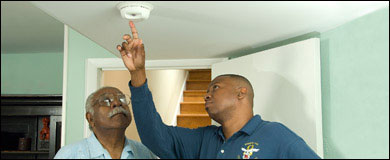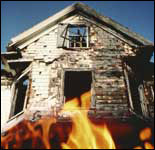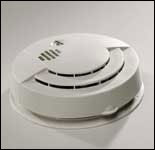Fire Prevention Week 2008 – Prevent Home Fires
 October 5-11, 2008 is Fire Prevention Week, and this year's theme is "Prevent Home Fires!" You can help keep your home fire-safe by following simple prevention tips.
October 5-11, 2008 is Fire Prevention Week, and this year's theme is "Prevent Home Fires!" You can help keep your home fire-safe by following simple prevention tips.
During Fire Prevention Week*, learn how you can make your home a safer place for you and your family. You can prevent home fires.
The Risk is Real
Home fires can cause death and injury. In the United States in 2006:

- Nine people died every day in home fires, and someone was injured every 32 minutes.
- Fire departments across the country responded to 412,500 home fires. These fires claimed the lives of 2,580 people and injured another 12,925.
- Four out of five fire deaths in happened in people's homes.
- 4% of U.S. homes don't have smoke alarms. 39% of reported home fires and nearly half of reported home fire deaths happen in homes without smoke alarms.
- Home fires affect young children, African Americans, Native Americans, and the poorest Americans more than any other groups.
You Can Prevent Home Fires
Your home should be a safe and comfortable place—and you can help keep it fire-safe by following these prevention tips.

Cook with care. When you cook, never leave cooking food unattended on the stove. Keep anything that can catch on fire, like potholders and towels, away from the cooking area. Avoid wearing clothes with long, loose-fitting sleeves that can catch on fire. Also, keep pot handles turned in.
Use caution if you smoke at home. Don't smoke inside your home. If you do smoke in your home, never smoke in bed or leave burning cigarettes unattended. Also, don't empty burning or hot ashes in a trash can, and keep ashtrays away from upholstered furniture and curtains.
Stay warm—safely. If and when you use a space heater, keep it more than three feet of anything that can catch on fire, like draperies.
Be alarmed. Install smoke alarms on every floor of your home, including the basement, and make sure you have smoke alarms near all sleeping rooms. Test all smoke alarms once a month using the test button.
Have an escape plan. Create a home fire escape plan. Know at least two ways out of every room, if possible, and have a meeting place outside. Practice your escape plan twice a year.
Learn More about How to Prevent Home Fires

- CDC Fire Deaths and Injuries Fact Sheet
- Residential Fire H.E.L.P. podcast (2007) (
 2:34 minutes)
2:34 minutes) - Information Resources for Eliminating Residential Fire Deaths, FireSafety.gov
- Fire Safety Week Information,* National Fire Protection Association
- Safety Tips for Adults,* National Fire Protection Association
- Safety Tips for Kids,* National Fire Protection Association
- Safe Kids Worldwide*
- Fire Safety Publications, US Consumer Product Safety Commission


